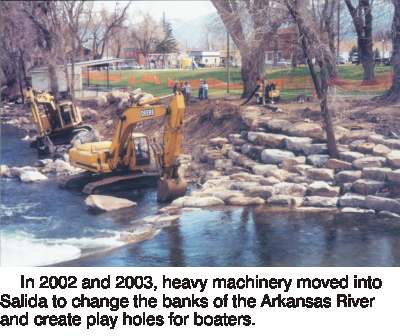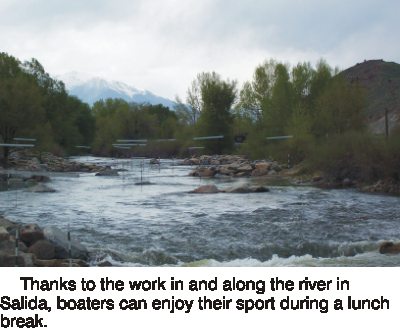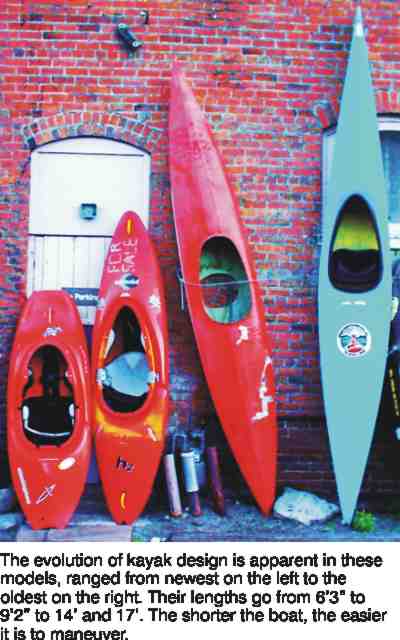Article by Brad Goettemoeller
Recreation – June 2004 – Colorado Central Magazine
WHITEWATER FESTIVALS have always been a celebration of the river — and of those who run the river.
But in recent years the festivals have become more popular and higher profile, and thus they deliver a larger economic impact. As a result, festival organizers have had to become more knowledgeable about industry trends.
The whitewater industry has changed. And therefore whitewater festivals have had to change.
In recent years, professional kayakers have pushed the limits of the sport. Runs that used to be considered class VI or unrunnable are now routinely run at all levels. Tricks that just five years ago were unimaginable, are now basic moves — even for amateurs.
Manufacturers have greatly improved whitewater equipment and gear. In the early 90’s, kayaks were long, straight, and less durable. Today kayaks are short, with many complex curves, and they’re virtually indestructible. Paddles and helmets are made out of carbon fiber and Kevlar. Life jackets — now called personal flotation devices or “PFD’s” — are very trim and allow for greater freedom of movement.
Because of these innovations, contemporary whitewater festivals often attract hundreds of competitors and thousands of spectators. The modern festival is focused on the freestyle event; whereas ten years ago the downriver and slalom races were the focal points of whitewater festivals.
The sport of kayaking has blossomed in the last two decades, and an entire industry has formed to support it. Kayak shops have sprung up in every little town with a river nearby.
![Kayaks, newest on left] Kayaks, newest on left]](https://coloradocentralmagazine.com/wp-content/uploads/2009/12/01240161.jpg)
A Kayak History Lesson
Until the eighties, kayaks were as long as 15′ and were made of fiberglass by enthusiasts in garages and workshops across the country. There were a few fledgling companies making boats and accessories like splash jackets, paddles, helmets and the like, but the fledgling industry was trying to figure out what would work.
Fiberglass boats were fast and light but not very durable. The advent of the roto-molded plastic kayak helped to spawn an industry. Perception pioneered this technology. Next came Dagger, Prijon, Pyranha, Wavesport, Riot, Eskimo, Liquid Logic, Bliss-Stick, Necky, and on and on it goes. Since the late eighties the industry has morphed into a large, fast moving, high-tech industry.
Kayak manufacturers used to create a new boat design every few years. Now they create as many as six or seven new models every year. Including accessory companies, there are now nearly 1000 equipment manufacturers in the whitewater kayaking industry.
You might ask, how many times can you re-invent the wheel? In the kayak market, there are three general types of wheels:
* First, a river running boat is designed with softer edges and more volume to assist newbies with learning the intricacies of the sport.
* Second, creek boats have blunt ends, high volume, and reinforcements for added strength. These boats are used to descend gnarly creeks that are as steep as 600 ft/mi.
* Third, there is the king of the new school, the freestyle kayak. These boats are short, with sharp edges, and low volume ends. They excel at surfing waves, carving, spinning, cartwheeling, and flipping end over end.
All of the newer boats are shorter than 9 feet long. In fact, all of this year’s freestyle boats are less than 7′ long, which is a far cry from the old downriver boats that were often more than 15′ long. As an example, my current kayak fits inside of my Ford Escort.
History of Whitewater Festivals
At 56, Salida’s FIBArk is the oldest whitewater festival in the country. It started out as a whitewater river race that was basically a challenge between friends. Then a parade and festival were organized around the race. For many years, the event has involved the local community of non-paddlers, which is unique for a whitewater festival. This tradition started in the early days when there weren’t enough whitewater enthusiasts to support a festival without including the rest of the community.
FIBArk is still the only whitewater festival in the country that involves the non-whitewater community, and it continues to be one of the top festivals in the nation — in part due to the unique flavor the community of Salida adds.
Very few people in Salida can remember a time when FIBArk didn’t exist. It now attracts thousands of people for a long weekend of entertainment, and these visitors eat, drink, rent motels, and spend money all over town.
In 2004, there will be hundreds of whitewater festivals across the country, and they have all used FIBArk as a role model in one way or another. FIBArk has adapted so that it continues to be the biggest and best. However, as these new festivals spring up, the competition between festivals increases.
Because of the large economic impact these festivals are having on small mountain towns, wealthy, high profile communities are starting to get in on the act. Vail started the Vail Whitewater Festival in 1999 on tiny Gore Creek, which runs through Vail Village. That community invested thousands of dollars into their event, and it paid off. That festival is now the Teva Mountain Games and it integrates multiple sports into an event which attracts world-class athletes from around the world. In just a few short years, Vail’s event has become one of the largest and most notable sports festivals in the country.
River festivals are popping up in the most unlikely of places. For example, this year Reno, Nevada started the Reno River Festival. The Reno-Sparks Convention and Visitors Authority hope to create a top notch event, and have signed on the 2003 World Freestyle Champion, Jay Kincaid, to be their spokesman.
Instant Whitewater, Just Add Rocks

The new kayaks created a need for features such as waves and large recirculating hydraulics similar to the natural features found on the east coast where the mountains are older and the rocks are rounder. These natural whitewater features are perfect for freestyle kayaking but they aren’t always easily accessible.
Enter human ingenuity. Humans have been changing river beds for years to suit their interests. Most of these modifications have been for industrial purposes, such as water storage and hydropower. But now changes are being made in the name of fun.
The idea of the whitewater park is to create a whitewater feature or series of whitewater features where there were none before. These parks exist in many urban areas where the river has already been heavily manipulated. In those cases, industrial trash, household trash, and unstable banks have made the river unsafe and unusable.
Whitewater parks are designed for recreation, but they can improve many aspects of the river, including cleanliness, aesthetics, safety, and habitat.
In Salida, the reclamation of the river bank and creation of a whitewater park has turned the river walk into the unofficial “Salida Beach.” While kayakers enjoy the whitewater features, spectators lounge and relax on the river’s edge.
The rocks that create the park make natural eddies and deepen the pools of water, thereby improving the health of the fish habitat. Additionally, by showing a commercial need for instream flows, local governments have a better chance of fending off outside water interests. Overall, the health of the river increases.
In addition to the environmental benefits, whitewater parks can provide economic benefits — as communities create whitewater attractions where just the previous year, there wasn’t any whitewater.
Whitewater Freestyle vs. River Running
The whitewater freestyle event, also known as rodeo boating, calls for a competitor to stay in a specified area (where rushing water tends to sweep boats away) for as long as possible while doing tricks like spins, cartwheels, loops, or donkey flips. Each ride is judged and scored and the competitor with the highest score wins.
Before the advent of freestyle, the kayaker’s only choice was to run long stretches of river where the thrill was actually running the rapids. In that era, boaters generally tried to avoid large recirculating hydraulics because they were considered dangerous.
In addition, river running usually involved using two vehicles to run a shuttle. Therefore, you had to find someone to go with you, and an outing generally required at least three to four hours.
Nowadays, you can go to a whitewater park where the thrill is performing tricks in a large recirculating hydraulic. With freestyle boating, you can get a good workout in an hour; there will almost always be someone else in the park; and it only requires one vehicle to get there and back.
The whitewater park has made the sport more accessible to people with busy schedules. You can kayak on your lunch break or after work before heading home to other commitments. Young kayakers don’t necessarily have to be able to drive to participate, and there are usually people around to look after them. And most importantly — here in the dry west — you don’t need lots of water.
Kayakers still want to get out and run rivers but the goal of river running has changed. The tricks you learn at whitewater parks, can be attempted in natural features on rivers everywhere. A day out on the Numbers is no longer just about navigating the rapids; it’s about navigating the rapids to find good play spots where you might stay for 15 or 20 minutes.
The growth and innovation of the whitewater kayaking industry has made the sport more accessible and easier to learn. Which has, in turn, expanded the consumer base, which has forced manufacturers to innovate more. In essence, the fledgling industry has matured.
What’s in store for the future
Currently, FIBArk is still considered the #1 whitewater festival in Colorado. It was ranked #2 in the nation behind the Gauley Fest in West Virginia by Kayak Magazine, Spring 2004. In fact, the general consensus of the boating community is that FIBArk had it’s best festival among recent years in 2003. This was due to the great whitewater park, the friendly people, and the hard work of the FIBArk board of directors and other volunteers.

The FIBArk board has made strong alliances in recent years to strengthen it’s position. A sponsorship agreement with New Belgium Brewing furnishes not only funding and beer, but brand recognition and environmental awareness. New Belgium encourages recycling at the event by using compostable cups when dispensing beer. FIBArk is also being included in the new Colorado Cup kayak freestyle points series.
As the volunteer board members change from year to year, consistency can be a problem. FIBArk is the only major whitewater festival in the country where all of the organizers and most of the vendors are not paid. The fact that it is ranked #2 in the country speaks volumes for the passion of the volunteers throughout the history of the event.
But to solve the problem of consistency, a major shift in organization may be necessary. One proposed solution is to make the board of directors the advisors to a paid staff that manages the event all year long. The event would continue to rely on a large group of volunteers, but a paid staff could offer more stability and consistency.
FIBArk has grown into a major whitewater event in recent years, but not without controversy. Several years back, many locals complained when beer booths were added; they questioned whether FIBArk and alcohol were a good combination — and also whether outside concessionaires were good for local bars and restaurants.
To complicate matters, those first “beer gardens” sat in the middle of the park, and youngsters were frequently yelled at for sitting in the brew tents or crossing through them. But the controversy over alcoholic beverages faded after the beer was moved to the side of the park, and no longer blocked the primary routes to the bandstand.
Contention, however, is probably inevitable now that FIBArk is a major festival.
Last year, FIBArk was an unqualified success as a whitewater festival. But after the event, many Salidans complained about the scarcity of arts and crafts booths. So this year, local artists are once again being encouraged to display their wares.
The goal of the current FIBArk board is to create the strongest festival possible by having a consistently high quality event.
Presently, FIBArk is a world-class whitewater event and a time-honored community festival. Combining those two concepts hasn’t always been easy, but it has definitely been a winning combination.
To stay competitive with the proliferation of hip new whitewater festivals, those responsible for FIBArk’s future will have to develop new ways to attract the best whitewater athletes and lure spectators. But Salidans also expect the board to preserve the traditions of a regional festival that’s been around for more than half of a century.
The FIBArk Board’s challenge in coming years will be to balance such contradictory needs, while maintaining the festival’s remarkable success.
In 2004, FIBArk continues its unparalleled history as a first-class whitewater festival and an old-fashioned community celebration by featuring the prestigious 26-mile downriver race, and the incredible acrobatics of the Whitewater Freestyle Competition, along with a parade, carnival, arts, crafts, food vendors, and live music, plus the annual air band competition, Tender Foot Hill Climb, Hooligan Race, and Rubber Duck regatta.
This summer the Heritage Museum in Buena Vista is hosting a display on the history of kayaking, which will be shown in Salida during the festival weekend, June 17 – 20.
Brad Goettemoeller was raised in Salida Colorado, and has attended 28 FIBArk’s in a row. He was a marketing event manager at Hewlett-Packard for 4 years, and is the founder of allaboutrivers.com, a member of the FIBArk board, and has traveled the U.S. in search of the best rivers and festivals.

